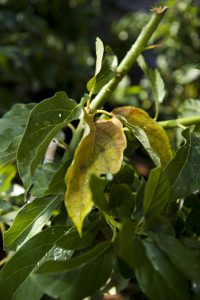When it comes to managing invasive species or disease epidemics, success relies upon not only the existence of effective management strategies but also the decision-making of impacted populations to use them and of policymakers to implement strategies that encourage them.

A new research paper authored by FRE faculty members Dr. Kelly Grogan and Dr. Trent Blare, along with other collaborators at UF, looks at how information, types of policy, and social networks impact grower decisions when choosing management policies for laurel wilt amongst avocado growers in Florida.
Laurel wilt is an infectious horticultural disease carried by the red bay ambrosia beetle, which since its introduction as an invasive species, has spread through much of the Southeastern United States. Since its introduction, it has already devastated the Florida avocado industry, as avocado trees, as a laurel species, are particularly susceptible.
In South Florida, Dr. Blare said that about one-third of avocado production has been impacted as a result of laurel-wilt disease already.
While this on its own is concerning, experts say the bigger threat to the avocado industry as a whole lies on the horizon should the laurel wilt disease spread beyond the Southeastern United States into California and Mexico, where the majority of avocados are grown.
“If you’re an avocado consumer, you should be pretty concerned because if we cut out a third of the production. Mexico produces 91% of the avocados consumed in the U.S. and provides about 28% of the avocados in the world,” Blare said. “Can you imagine what happened to avocado prices if a third of production was lost?”
For this study, Grogan and Blare collaborated with many colleagues across the disciplines of plant pathology, entomology, horticulture, and agricultural extension to develop a model of grower decision-making that could illustrate how likely growers would be to implement high, medium or low-effort management strategies, and what the results of that management would be.
“These models are decisions that really require all of those areas of expertise,” Blare said.
While Grogan and Blare used their expertise to develop and strengthen the economic model by looking at the costs and benefits of different management policies, others provided expertise on modeling the disease spread, looking at the insects as a vector for disease spread, and understanding factors that go into the grower’s decision-making process such as their social networks and stubbornness.
The results showed that stubborn growers were more likely to adopt the higher-effort policy in the long term, that policy incentives were less effective than policy deterrents in encouraging the uptake of the low-effort management strategy, and that social connections made growers less likely to invest in the management strategies.
The model was designed to be flexible and reactive so that it could be used with various types of management strategies as they become available.
For this paper, the authors were recognized with the AAEA Outstanding Published Paper for Transdisciplinary Work on Specialty Crop Industries from the AAEA Specialty Crops Section.
Moving forward, their research continues on the subject to better understand how the model may be applied to real-time grower decisions when it comes to managing laurel wilt disease in avocados.
“I’m working with Dr. Karen Garrett from UF/IFAS Plant Pathology to develop a survey that will go out to our growers here in Florida and then also California and, I think, Texas to try to collect more information about what they’re actually doing across different states with regard to laurel wilt, what their concerns are, what they’re willing to do, and to get a little more empirical evidence because this is just really a theoretical model,” Grogan said.
To read the full article, visit ScienceDirect.
Additional Information:
Avocado Production statistics provided by Dr. Blare are based upon the Food and Agriculture Organization of the United Nations database which provides food and agriculture data for over 245 countries and territories from 1961 until 2021 (most recent year available). This database is available at http://faostat.fao.org/
 3
3
